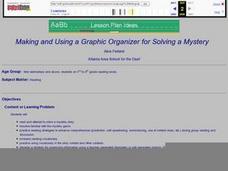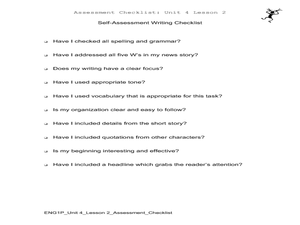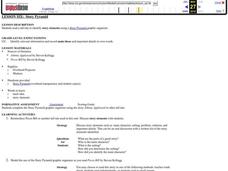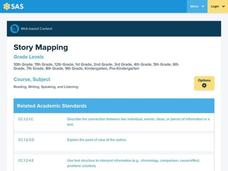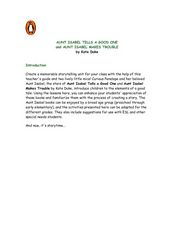Curated OER
Graphic Organizer: Story Pyramid
In this graphic organizer: story pyramid worksheet, students analyze 6 components of the story (exposition, conflict, rising action, climax, falling action, resolution) and write the details in the boxes.
Curated OER
Making and Using a Graphic Organizer for Solving a Mystery
Students create tables in a word processing program which helps them organize their text clues when reading a mystery story. They develop reading comprehension strategies while using a computer based graphic organizer in order to solve...
Curated OER
Identifying Story Elements
Help your class identify story elements. They will discuss character, setting, problem, and solution after reading a story. A graphic organizer will help them to identify various elements with guided practice and independent practice...
Curated OER
Detail Detective: Story Activity
In this story detail worksheet, students complete a graphic organizer, filling in details about a story read and what characters see, hear, smell, taste, touch and where they go.
Reading for Meaning
Sample Lessons and Worksheets
If you need to bulk up your reading comprehension worksheet collection, take a look at a resource that includes graphic organizers and reading comprehension questions. The series of 50 worksheets addresses novels such as Julie of...
Curated OER
Story Mapping
Fill-out a story map to help your scholars with pre-writing. They will use a story map template to pre-write. They also organize their ideas into steps which become the foundation for their first draft. Concrete objects are brought in to...
Teaching Tolerance
In Our Own Words: A Story Book with a Purpose
Academics turn into storytellers in an engaging activity on activism. The activity focuses on promoting social change in local communities with stories. Young historians plan a storybook to target a specific audience and social issue and...
Curated OER
Story Elements
Review story elements with your class using this resource. Learners can take a story they have read as a class and identify story elements. They focus on characters, setting, the introduction, and plot. Then, they use graphic organizers...
Curated OER
Story Web
Use a graphic organizer or story web to show the relationship between plot and character. They note the setting, characters, title, author, conflict, and solution regarding short story or novel they have read.
Curated OER
Who Am I?
Your budding journalists need to understand the five W's for writing a news story. They read a story, complete several graphic organizers to help them organize and write their article, and then use a self-assessment worksheet to edit and...
Curated OER
Story Train
In this story sequencing worksheet, students will record the beginning, middle and ending of the book that they are reading on a graphic organizer in the shape of a train.
Curated OER
Story Pyramid
Students read tall tales to identify story elements. In this story elements instructional activity, students read about Johnny Appleseed and Pecos Bill and use graphic organizers to record information. Students read in small groups,...
Curriculum Corner
Fiction Graphic Organizers
Accompany fictional reading with a worksheet that compares a story's characters, setting, and theme.
Curated OER
Literary Elements Worksheets and Graphic Organizers
Using graphic organizers can be an effective way to teach literary elements.
Teaching Oasis
Gingerbread Baby Lesson Plan Guide
Reinforce reading comprehension and story mapping skills with the help from a story, Gingerbread Baby by Jen Brett. Individuals discover new vocabulary, make predictions, retell main events, respond to reading using a graphic...
Curated OER
"The Story of an Hour" Lesson 5: Teacher's Guide and Notes
Learning how to craft a compelling argument supported by evidence and logical reasoning is an essential skill. The fifth lesson in "The Story of An Hour" unit asks young scholars to formulate an argument in response to the question, 'Is...
Scholastic
Story Map
Simplify a short story or novel in your language arts class with a story map. The graphic organizer includes fields such as title and author, main characters, and problem and solution.
Curated OER
Using Graphic Organizers to Generate Genre Definitions
Learners listen to or read a variety of stories and then work individually or in groups to complete graphic organizers that will help them focus on elements within different types of stories. They write definitions for a variety of story...
Curated OER
Story Mapping
Students prewrite a story using graphic organizers. In this prewriting lesson plan, students create a story map before they start their writing.
Curated OER
Short Story Elements
Learners engage in a activity that investigates the elements that are necessary in a short story. Each element is covered separately while they take notes for each part. Then the teacher points out each element while reading a short...
Curated OER
Story Map
In this story map worksheet, students write about a story's setting, characters, problem, and solution. The worksheet is organized as a graphic organizer.
Curated OER
Story Map
In this story map worksheet, learners fill out a graphic organizer about a story. Students write about the story's characters, setting, problem, solution, and theme.
Curated OER
Developing a Topic for Writing Using an Idea Web
Teach your upper graders how to use an idea web to develop a topic for writing. After reading a variety of stories about friendship (a list of stories with the theme of friendship is included), model using an idea web. Class members...
Curated OER
Aunt Isabel Tells a Good One...
Explore language arts by reading two similar stories in order to compare and contrast them in class. Young readers read two Aunt Isabel books, by Kate Duke, and discuss the main characters, plot, and setting. They complete a graphic...

